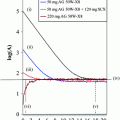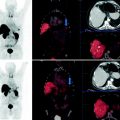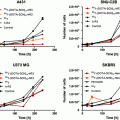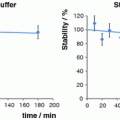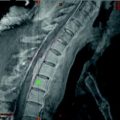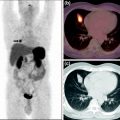Site
Number of cases (histology–neuroendocrine cancer)
1998–2002
2003–2007
1998–2007
Percentage of tumor of the site
Nasopharynx (ICD-9 147)
3
3
6
0.2
Esophagus (ICD-9 150)
3
3
6
0.7
Stomach (ICD-9 151)
19
20
39
0.9
Small intestine (ICD-9 152)
13
21
34
12.6
Colon (ICD-9 153)
39
46
85
1.1
Rectum and anus (ICD-9 154)
65
101
166
3.2
Liver (ICD-9 155)
3
1
4
0.3
Gall blabber and extrahepatic bile duct (ICD-9 156)
2
3
5
0.8
Pancreas (ICD-9 157)
8
22
30
2.8
Retroperitoneum and peritoneum (ICD-9 158)
1
0
1
0.7
Nasal cavities and sinuses (ICD-9 160)
5
3
8
3.4
Larynx (ICD-9 161)
1
2
3
0.4
Lung (ICD-9 162)
59
51
110
1.2
Thymus and mediastinum (ICD-9 164)
6
3
9
4
Skin excluding melanoma (ICD-9 173)
2
0
2
0.1
Female breast (ICD-9 174)
4
8
12
0.1
Cervix uteri (ICD-9 180)
11
8
19
0.9
Corpus uteri (ICD-9 182)
3
2
5
0.2
Ovary and uterine adnexa (ICD-9 183)
1
4
5
0.2
Vagina and vulva (ICD-9 184)
0
1
1
0.5
Prostate (ICD-9 185)
0
4
4
0.1
Bladder (ICD-9 188)
6
1
7
0.4
Other endocrine glands (ICD-9 194)
1
1
2
1.2
NETs are defined as epithelial neoplasms with predominant neuroendocrine differentiation, arising in most organs of the body (Modlin et al. 2008). NETs constitute a heterogeneous group of tumors that frequently express cell membrane-specific peptide receptors, such as somatostatin receptors (SSTRs) (Kaltsas et al. 2005). At least five SSTR subtypes have been identified (SSTRs 1–5) (Reisine and Bell 1995). Of NETs, 70–90% express SSTR-2 and SSTR-5 (Papotti et al. 2002). Diagnosis of NET primaries and metastases is challenging, as these lesions are small in size with variation in many anatomical locations. Radiolabeled peptides bind to SSTR and provide in vivo histopathological information for diagnostic purposes (Signore et al. 2001). Peptides have fast clearance, rapid tissue penetration, and low antigenicity, features making them suitable as good targeting molecules for radiopharmaceuticals.
The commonest tracer for SPECT imaging is commercially available 111In-DTPA-octreotide (111In-Octreoscan®) with detection sensitivity of 67–100% (Kaltsas et al. 2001, 2004). Diagnostic sensitivity of 18F-FDG is low for tumors with low proliferation index, slow growth rate, and low glucose consumption such as NETs (Adams et al. 1998; Belhocine et al. 2002). Many 68Ga radiopharmaceuticals have been used for SSTR imaging. The efficiency of PET tracer 68Ga-DOTATOC for detecting NETs is better than that of 111In-Octreoscan® (Buchmann et al. 2007). 68Ga-DOTATOC is superior to 111In-DTPA-octreotide in detecting small tumors and tumors with low-density SSTR expression (Kowalski et al. 2003). Superior imaging quality of PET is attributed to improved detection by 68Ga-DOTATOC (Hofmann et al. 2001).
There is great interest in use of 68Ga radiopharmaceuticals due to:
1.
The availability of 68Ga from a 68Ge/68Ga generator
2.
Superior imaging quality of 68Ga–SSTR analogs over 111In-DTPA-octreotide
3.
Potential to switch to therapy with 177Lu and 90Y (theranostics)
4.
Possibility of the availability of cold kits
5.
As an alternative PET radioisotope to cyclotron-based 18F−
6.
As a PET equivalent to 99mTc radiopharmaceuticals for SPECT.
The parent, 68Ge with half-life of 270.8 days, is produced by accelerator. 68Ga has half-life of 68 min and decays by  of 1.92 MeV (89%) and electron capture (11%) (Maecke et al. 2005). A number of 68Ge/68Ga generator systems have been developed, with their unique advantages and disadvantages. The 68Ga generator with calcinated hydrous tin dioxide column has been in use for many years with average yield of 65%. 68Ge breakthrough was reported to be 6.1 × 10−4% (Aardaneh and van der Walt 2006).
of 1.92 MeV (89%) and electron capture (11%) (Maecke et al. 2005). A number of 68Ge/68Ga generator systems have been developed, with their unique advantages and disadvantages. The 68Ga generator with calcinated hydrous tin dioxide column has been in use for many years with average yield of 65%. 68Ge breakthrough was reported to be 6.1 × 10−4% (Aardaneh and van der Walt 2006).
 of 1.92 MeV (89%) and electron capture (11%) (Maecke et al. 2005). A number of 68Ge/68Ga generator systems have been developed, with their unique advantages and disadvantages. The 68Ga generator with calcinated hydrous tin dioxide column has been in use for many years with average yield of 65%. 68Ge breakthrough was reported to be 6.1 × 10−4% (Aardaneh and van der Walt 2006).
of 1.92 MeV (89%) and electron capture (11%) (Maecke et al. 2005). A number of 68Ge/68Ga generator systems have been developed, with their unique advantages and disadvantages. The 68Ga generator with calcinated hydrous tin dioxide column has been in use for many years with average yield of 65%. 68Ge breakthrough was reported to be 6.1 × 10−4% (Aardaneh and van der Walt 2006).68Ga-DOTATATE has higher sensitivity for low-grade tumors and greater avidity to well-differentiated NETs than 18F-FDG, which shows greater avidity to poorly differentiated NETs (Kayani et al. 2008). 68Ga-DOTATATE can identify additional lesions in patients with negative or equivocal 111In-DTPA-octreotide scans. It shows good lesion recognition in low-grade tumors and changes clinical management in 70.6% of patients (Srirajaskanthan et al. 2010). 68Ga-DOTATATE is superior to 18F-DOPA PET in evaluation of well-differentiated metastatic NETs (Haug et al. 2009).
The aim of this study is to determine feasibility of 68Ga-DOTATATE application in routine clinical practice for PET imaging of NETs in a limited number of patients (n = 6).
2 Materials and Methods
2.1 DOTA-Tyr3-Octreotate
DOTA-Tyr3-octreotate was purchased commercially (DOTA-dPhe-Cys-Tyr-dTrp-Lys-Thr-Cys-Thr-OH; molecular formula: C65H90N14O19S2; molecular weight: 1,435.6; purity (HPLC): >99%; peptide content: 86.8%). DOTATATE vials were prepared in house. A peptide vial contained 62.5 μg peptide, 0.25 mg gentisic acid, and 25 μL glacial acetic acid.
2.2 68Ge/68Ga Generator
Gallium generator (30 mCi) was purchased from iThamba and eluted with 0.6 M HCl (ultrapure). The elution profile was determined with 0.5 mL fractions of 0.6 M HCl for 10 mL, upon receipt of the generator. The generator was pre-eluted 2 h prior to the radiolabeling process with 5 mL 0.6 M HCl to flush impurities. The generator was eluted with three fractions of 0.6 M HCl (first 1 mL, second 1.5 mL, third 7.5 mL; fractionation method). The second, 1.5 mL fraction was collected for radiolabeling, whereas the first and third fractions were discarded.
2.3 68Ga Radiolabeling
Generator eluate (second 1.5 mL, pH 1) was added to a peptide vial, and the pH of the solution was immediately adjusted to 3.8–4.0 by adding 1 M sodium acetate solution. The vial was heated to 95–100°C for 10 min. The reaction mixture was cooled down to room temperature, and the purification was completed with C18 Sep-Pak cartridge, eluted with 2 mL 99.7% ethanol. It was reformulated with 1 mL 4.4% EDTA plus 9 mL sterile water for injection and filtered through 0.22-μM Millipore filter. Quality control was performed by radio-TLC with 0.1 M sodium citrate as mobile phase and silica gel as stationary phase with RCP >95%. Synthesis was done manually.
2.4 Scan Procedure
68Ga-DOTATATE (111–185 MBq, 3–5 mCi) was injected into patients with proven NET (n = 6), and 1 h post-injection scan was performed with 64-Slice GEMINI TF PET/CT. Patient studies were performed under a “name-patient permit” issued by the relevant regulatory authority.
3 Results and Discussion
3.1 Generator Elution Profile
The elution profile of the generator showed that the majority of activity was in the second, 1.5 mL fraction, while the first, 1.0 mL and third, 7.5 mL fractions contained negligible amounts of radioactivity (Fig. 1). This second, 1.5 mL fraction which contained the bulk of radioactivity was used for radiolabeling.
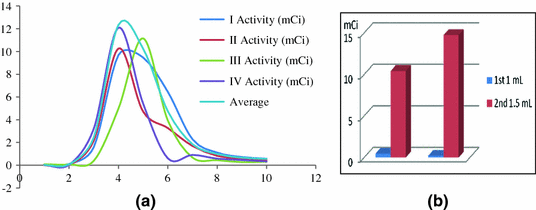

Fig. 1
a Elution profile of 68Ge/68Ga generator (x-axis, number of 0.5 mL fractions), b radioactivity contained in the first and second fractions
3.2 Post-Elution Processing
Metallic impurities in the generator eluate such as ZnII from decay, FeIII from the eluent, and metal ions from the generator column can greatly influence 68Ga radiolabeling. Post-elution processing of generator eluate can be achieved by cation exchange column, anion exchange column, combination of cation and anion exchange columns, and fractionation method (Zhernosekov et al. 2007; Roesch and Riss 2010). A fractionation method reported in literature was used in this study (Breeman et al. 2005). Though this method cannot chemically remove the metallic impurities, it can minimize the impurity content.
Stay updated, free articles. Join our Telegram channel

Full access? Get Clinical Tree


